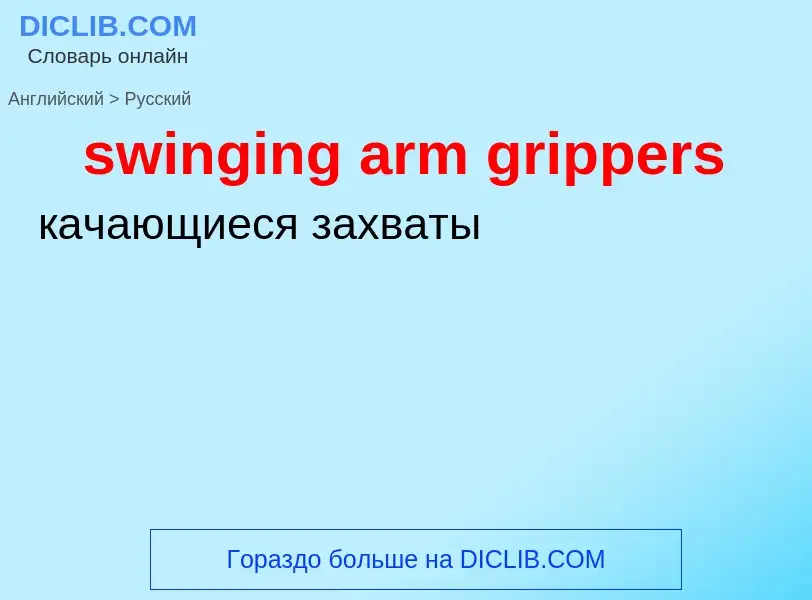Перевод и анализ слов искусственным интеллектом ChatGPT
На этой странице Вы можете получить подробный анализ слова или словосочетания, произведенный с помощью лучшей на сегодняшний день технологии искусственного интеллекта:
- как употребляется слово
- частота употребления
- используется оно чаще в устной или письменной речи
- варианты перевода слова
- примеры употребления (несколько фраз с переводом)
- этимология
swinging arm grippers - перевод на русский
['brei|ki(e)it'bræ{ki(e)it}-]
общая лексика
разветвлённый
разветвленный
зоология
имеющий руки
прилагательное
['brei|kieit'bræ{kieit}-]
зоология
имеющий руки
ботаника
ветвистый
разветвлённый
глагол
общая лексика
прыгать по веткам деревьев
хватаясь руками подобно обезьяне
общая лексика
брахиация
передвижение с помощью рук
Определение
Википедия

Brachiation (from "brachium", Latin for "arm"), or arm swinging, is a form of arboreal locomotion in which primates swing from tree limb to tree limb using only their arms. During brachiation, the body is alternately supported under each forelimb. This form of locomotion is the primary means of locomotion for the small gibbons and siamangs of southeast Asia. Gibbons in particular use brachiation for as much as 80% of their locomotor activities. Some New World monkeys, such as spider monkeys and muriquis, were initially classified as semibrachiators and move through the trees with a combination of leaping and brachiation. Some New World species also practice suspensory behaviors by using their prehensile tail, which acts as a fifth grasping hand. Evidence has shown that the extinct ape Proconsul from the Miocene of East Africa developed an early form of suspensory behaviour, and was therefore referred to as a probrachiator.
Upon further observations and more in depth understandings of the anatomy and behaviour of primates, the terms semibrachiator and probrachiator have largely fallen out of favour within the scientific community. Currently, researchers classify gibbons and siamangs as the only true brachiators and classify the great apes as modified brachiators. All other brachiation behaviours that do not meet either of these classifications are referred to as forearm suspensory postures and locomotion.
Some traits that allow primates to brachiate include a short spine (particularity the lumbar spine), short fingernails (instead of claws), long curved fingers, reduced thumbs, long forelimbs and freely rotating wrists. Modern humans retain many physical characteristics that suggest a brachiator ancestor, including flexible shoulder joints and fingers well-suited for grasping. In lesser apes, these characteristics were adaptations for brachiation. Although great apes do not normally brachiate (with the exception of orangutans), human anatomy suggests that brachiation may be an exaptation to bipedalism, and healthy modern humans are still capable of brachiating. Some children's parks include monkey bars which children play on by brachiating.
As well as shaping the evolution of gibbon body structure, brachiation has influenced the style and order of their behaviour. For example, unlike other primates who carry infants on their back, gibbons will carry young ventrally. It also affects their play activities, copulation, and fighting. It is thought that gibbons gain evolutionary advantages through brachiation and being suspended by both hands (bimanual suspension) when feeding. While smaller primates cannot hold themselves by both hands for long periods, and larger primates are too heavy to exploit food resources on the ends of branches, gibbons can remain suspended for a significant period and use their long arms to reach food in terminal branches more easily. Another theory postulates that brachiation is a quieter and less obvious mode of locomotion than quadrupedal jumping and climbing thereby more successfully avoiding predators.

![Brachiating primates such as this [[siamang]] (''Symphalangus syndactylus'') have long forelimbs and curved fingers Brachiating primates such as this [[siamang]] (''Symphalangus syndactylus'') have long forelimbs and curved fingers](https://commons.wikimedia.org/wiki/Special:FilePath/Brachiate.jpg?width=200)
